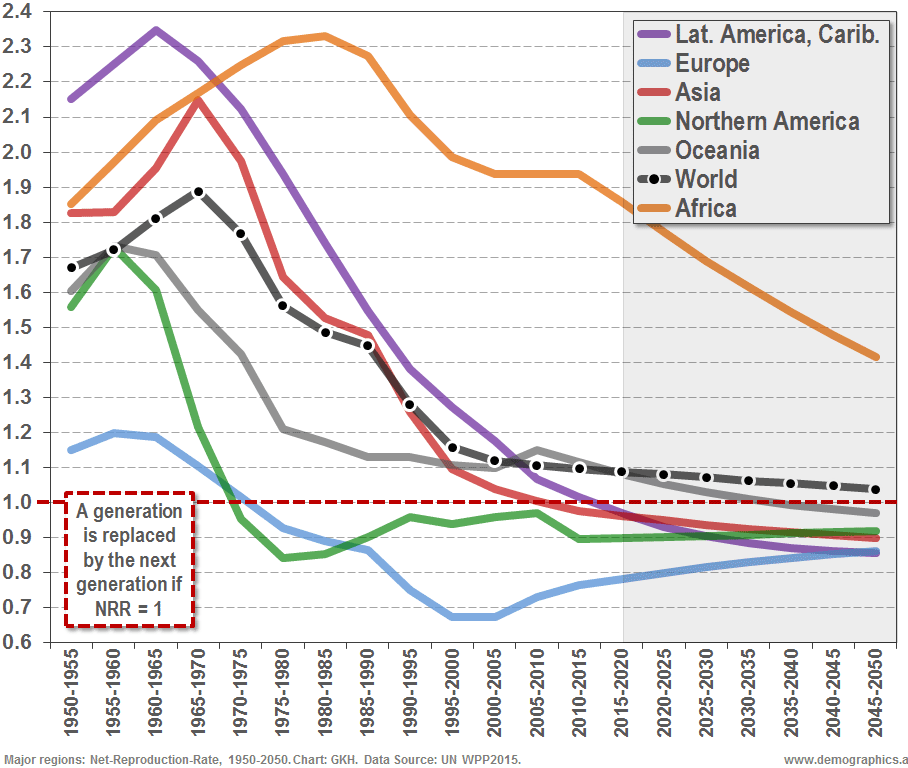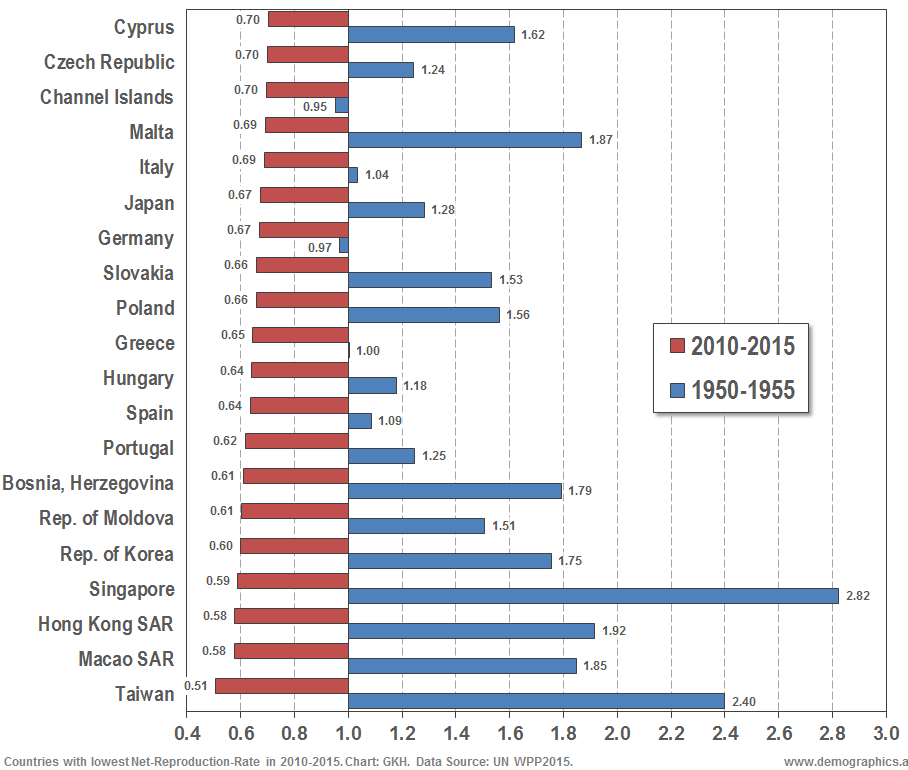
Note: Scale starts at 1 child per woman.
Since then average fertility has always been below the replacement level. Today, average fertility in Europe (including the Russian Ferderation) is around 1.6 children per woman. In Northern America, average total fertility is somewhat higher at 1.9 children per woman. However, there are enormous racial and ethnic differences: White people, on average, have much lower fertility than black people or the Latino population.
Note: Scale starts at a NRR of 0.6.
A Net Reproduction Rate of 1 indicates that one generation is precisely replaced by the next generation. With a NRR of below 1 the population is (intrinsically) shrinking, with a NRR of more than 1 the population is growing.
Currently, the world is growing with about 10% between generations (NRR = 1.1); Africa's population is increasing between generations by more than 90% (NRR = 1.94). Its population is almost doubling between generations. The population in Northern America and Europe is (intrinsically) shrinking by 10% and 24%, respectively (NRR = 0.9 and NRR = 0.76).
Note: Scale starts at 0.5 children per woman.
Note: Scale starts at 0.5 children per woman.
In the absense of significant immigration sub-replacement fertility quickly leads to notieable population decline. Japan's population, for instance, is expected to drop from 127m to around 87m by 2060. Very rapid population delcine is also projecte for Eastern European countries.
The most important consequence of sub-replacement fertility is population ageing. As the number of births declines with each subsequent generation, the base of the population pyramid is getting smaller and smaller. Eventually, this aging process will come to an end after many decades and a new stable age structure of the population will emerge - a so-called "stable population". At that stage population ageing will stop, but the population will continue to shrink.
Countries with sub-replacement fertility will usually develop problems with their pension system and the care of elderly. With fewer births the working-age population will eventually start to shrink. Fewer people will have to provide for the elderly - either by funding "pay-as-you-go" pension systems; or by providing intra-family services. Even with savings- or investment-based pension systems, the working age population must make sure that the economy is growing - otherwise the investments or savings of their parents might become devaluated.
With sub-replacement fertility private wealth is getting more concentrated. With a shrinking number of children each family's wealth is distributed among a smaller number of heirs. Private wealth will thus become more concentrated, as relatively large generations of older people bequest their estates to a smaller number of younger people. In fact, the inherited concentration of private wealth in aging societies may contribute to the increasingly uneven distribution of wealth that we can observe in recent years.
Sub-replacement fertility is frequently associated with rural depopulation, as both trends are a consequence of a modern urban life style. In Japan, for instance, some 500 or more towns across the country will disappear by around 2040 as young women migrate to bigger cities. Large parts of Europe are also facing a demographic collaps in the rural areas.
Political and economic pressure for allowing large-scale immigration is rising with stagnating or shirinking numbers of people in working age. Especially in highly industrialized countries with great demand for qualified labor, a shrinking labor force is usually seen as a great economic risk. This explains, why in countries such as Germany, economists and managers are prominent among those that favour large-scale immigration.
At the family level sub-replacement fertility is often straining human relations. The large number of single children, that is a consequence of sub-replacement fertility, can lead to social stress, as these children are pampered by parents and grandparents. The self-centered, narcicistic "Generation Y" (the "Millenials") may be one of the consequences of extremely low fertility in the 1980s and 1990s.
Caldwell, J.C. and T. Schindlmayr. 2003. Explanations of the fertility crisis in modern societies: a search for commonalities. Population Studies, 57(3):241-263.
González, M.J. and T. Jurado-Guerrero. 2006. Remaining childless in affluent economies: a comparison of France, West Germany, Italy and Spain, 1994–2001. European Journal of Population 22(4):317-352.
Kohler, H.-P., F.C. Billari, and J.A. Ortega. 2002. The Emergence of Lowest-Low Fertility in Europe During the 1990s. Population and Development Review 28(4):641-680.
Lutz, W., V. Skirbekk, and M.R. Testa. 2006. The Low Fertility Trap Hypothesis. Forces that May Lead to Further Postponement and Fewer Births in Europe. Vienna Yearbook of Population Research 2006:115-151.
Sobotka, T. 2004. Is Lowest-Low Fertility in Europe Explained by the Postponement of Childbearing? Population and Development Review 30(2):195-220.
Traister, Rebecca. 2016. All the Single Ladies: Unmarried Women and the Rise of an Independent Nation. Simon & Schuster. ISBN-10: 1476716560




